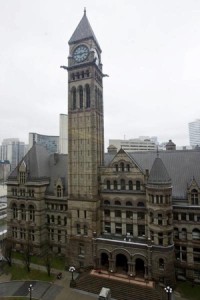Will an iconic piece of Toronto architecture turn into a shopping centre?

Last year in Professor Berger’s criminal law class, a few friends and I went down to Old City Hall for the afternoon to watch bail court for an assignment. A few of us had never entered the building before, so we were pretty excited to see what it looked like, and since the facade of the Old City Hall is pretty remarkable, we had high hopes. Hopes that were dashed, as we sat in the basement of the building, in a waiting room of crumbling plaster lined with scotch taped scraps of paper. Our hopes were further dashed as we entered into the bail courtroom, which had no ceiling beyond a network of pipes and exposed wires running through the room.
There are parts of the once magnificent interior that can still impress, such as the grand staircase, the original mosaic floor, and the lavish use of marble. This is a building that cost two and a half million dollars to build when the cornerstone was laid in 1891. In the past decade, the city has spent more than a few millions to renovate the exterior of the fantastic Romanesque Revival building created by E.J. Lennox (who is probably best known as the architect of Casa Loma). But the interior of Old City Hall has seen much better days, and to be honest, probably deserves a little more dignity than the administrative mish-mash of plaster partitioning, ugly fluorescents, and “no photography” signs that litter the walls. The city of Toronto seems to agree, and has already given notice to the provincial government that it is not looking to renew the lease that expires at the end of 2016. Meanwhile, the city also hired a real estate brokerage firm, Avison Young, to prepare a report on the building and conduct a “highest and best use” analysis for what can be done with the property.
That report, which can be viewed online in its entirety if you are into that sort of thing (as I clearly am), first suggests, quite reasonably, that the city should extend its lease to 2021, giving the province time for a new courthouse to be built. It then goes on to say that the highest and best use for the property would be “conversion to a retail centre that contains a mix of food service, leisure, event and civic uses.” Immediately, a thousand voices across the internet screamed. “A MALL?” they exclaimed, shaking their heads in disbelief, “How shameful! It should be a museum!”
These knee-jerk reactions are exactly why I decided to read the actual report and not just the internet comments from a few opinion pieces in newspapers. Nowhere in the report does it say “let’s make the whole thing a mall.” In fact, quite a lot of discussion is given to the idea of creating a city of Toronto museum either in the courtyard (which is now a parking lot and loading space) or elsewhere onsite. Don’t get me wrong, as a former art history student I am obsessed with museums. But turning the entirety of the building into a Toronto historical museum is somewhat unrealistic—the building is quite large and needs a fair amount of income to be maintained. But the idea that the building will turn into a new Eaton Centre is probably a bit of a stretch, considering that Old City Hall has been a national heritage site since 1989, and therefore would be difficult to overhaul in any significant way.
The report does a good job of analyzing the competing objectives of the potential project—maximizing assets, respecting the heritage of the building, attracting a mix of tenants, and, interestingly, an emphasis on unfettered public access. I find this enthralling because a lot of the complaints people have about turning the space into a retail-centre mention the space shouldn’t be used for “private” purposes, such as stores. But as the building stands now, it is pretty inaccessible to the average person, requiring a fairly invasive security check to enter, prohibiting photography, and having large areas of the complex completely closed to the public at all times. Imagine instead a building where tourists and Torontonians alike can walk into the great hall and admire its architecture, take pictures of its restored stained glass, grab a bite to eat, head to the museum courtyard, and purchase some Toronto souvenirs. I do not think that this would be disrespecting the original idea for the building to be a grand monument to the city. And it would certainly be a hell of a lot better use for the place than a condominium or a hotel.
Among retail space, office use, and a technology and innovation centre, the report also lists “post-secondary education” as one of the possible tenant uses of the building. I mean, I’m not implying that we should move all of Osgoode Hall Law School down there, but how cool would it be to have some class space in a heritage building that served as the city’s civic centre for a hundred years? Sign me up for “The History of Canadian Law” taught at the New Old City Hall Mall.
